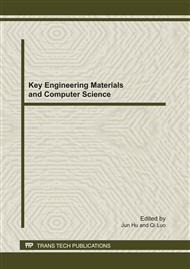[1]
S. Wax. and R. Sands. Electroactive polymer actuaotors and devices[C]. Smart Structures and Materials: Electroactive Polymer Actuators and Devices(EAPAD) , ed.Y. Bar-Cohen, Proc. SPIE 3669, pp: 2-10, (1999).
DOI: 10.1117/12.349666
Google Scholar
[2]
Harsha Prahlad, Roy Kornbluh, et al. Polymer Power: Dielectric Elastomers and Their Applications in Distributed Actuation and Power Generation[C]. Proceedings of ISSS 2005 International Conference on Smart Materials Structures and Systems, Bangalore, India, 2005, SA13.
Google Scholar
[3]
R. Kornbluh,R. Pelrine,Q. Pei,M. Rosenthal,S. Stanford,N. Bonwit,R. Heydt,H. Prahlad, andS. ShastriApplicaton of Dielectric Elastomer EAP Actuators[C]. Chapter 16 in Electroactive polymer(EAP)Actuators as Artificial Muscles: Reality, Potential and Challenges, Y. Bar-Cohen, ed. 2nd edition, SPIE Press, Bellingham, Washington, pp: 529-589, (2004).
DOI: 10.1117/3.547465.ch16
Google Scholar
[4]
P. Sommer-larsen, J. Hooker, G. Kofod, K. West, M. Benslimane, P. Gravesen, Response of dielectric elastomer actuators, Proc. Smart Structures and Materials 2001: Electroactive Polymer Actuators and Devices(EAPAD), pp.157-163, (2001).
DOI: 10.1117/12.432641
Google Scholar
[5]
N. C. Goulbourne, E. M. Mockensturm and M. I. Frecker, Electro-elastomers: Large deformation analysis of silicone membranes, International Journal of Solids and Structures, Vol. 44, Issue 9, pp.2609-2626, (2007).
DOI: 10.1016/j.ijsolstr.2006.08.015
Google Scholar
[6]
Kwangmok Jung , Kwang J. Kim, Hyouk Ryeol Choi. A self-sensing dielectric elastomer actuator[J]. Sensors and Actuators, 143 (2008) 343–351.
DOI: 10.1016/j.sna.2007.10.076
Google Scholar
[7]
C. Jean-Mistral, S. Basrour, J.J. Chailloutand A. Bonvilain. A Complete Study of Electroactive Polymers for Energy Scavenging: Modeling and Experiments[C]. EDA Publishing/DTIP (2007).
Google Scholar
[8]
C. Graf, J. Maas, and D. Schapeler, Energy harvesting cycles based on electro active polymers, Proceedings of SPIE, vol. 7642, (2010).
DOI: 10.1117/12.853597
Google Scholar
[9]
Curtis M. Ihlefeld and Zhihua Qu. A Dielectric Electroactive Polymer Generator-Actuator Model: Modeling, Identification, and Dynamic Simulation[C]. Proc. of SPIE Vol. 6927 69270R-1.
DOI: 10.1117/12.775544
Google Scholar
[10]
LA. Toth, Goldenberg. AndrewA, Control System Design for a Dielectric Elastomer Actuator: the Sensory Subsystem[C]. Smart Structures and Materials 2002: Electroactive Polymer Actuator and Devices (EAPAD), ed.Y. Bar-Cohen, Proc. SPIE 4695, pp: 323-334, (2002).
DOI: 10.1117/12.475179
Google Scholar
[11]
S. SOULIMANE, et al. Modeling of Smart Compliant Electro-Active Polymer Actuator[C]. 9th. Int. Conf. on Thermal, Mechanical and Multiphysics Simulation and Experiments in Micro-Electronics and Micro-Systems, EuroSimE (2008).
DOI: 10.1109/esime.2008.4525041
Google Scholar
[12]
Jugen Maas, Christian Graf and Lars Eitzena. Control Concepts for Dielectric Elastomer Actuator[C]. Smart Structures and Materials 2011: Electroactive Polymer Actuator and Devices (EAPAD), ed.Y. Bar-Cohen, Proc. SPIE 7976, pp: 1H-1-1H-12, (2011).
DOI: 10.1117/12.879938
Google Scholar


